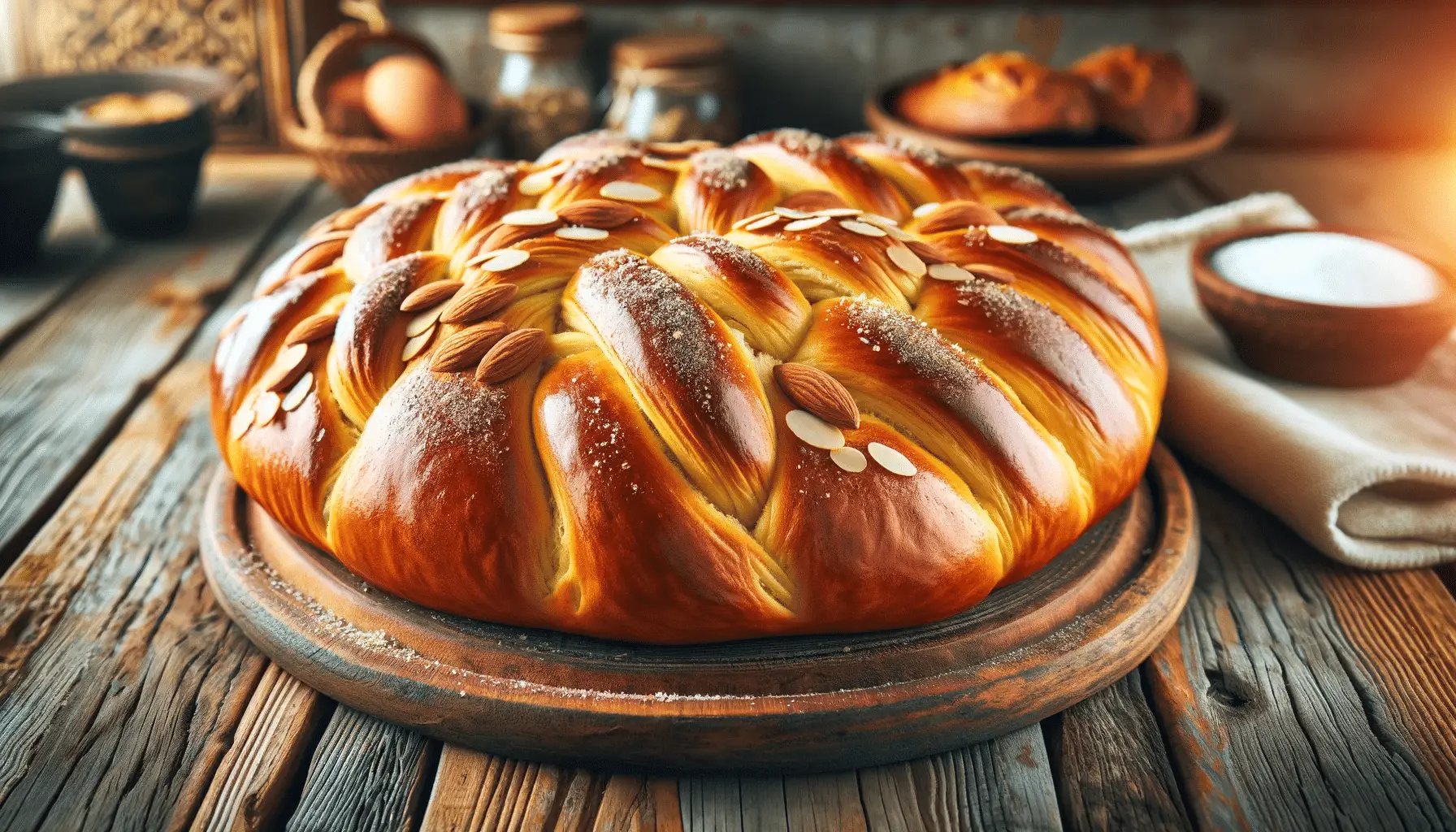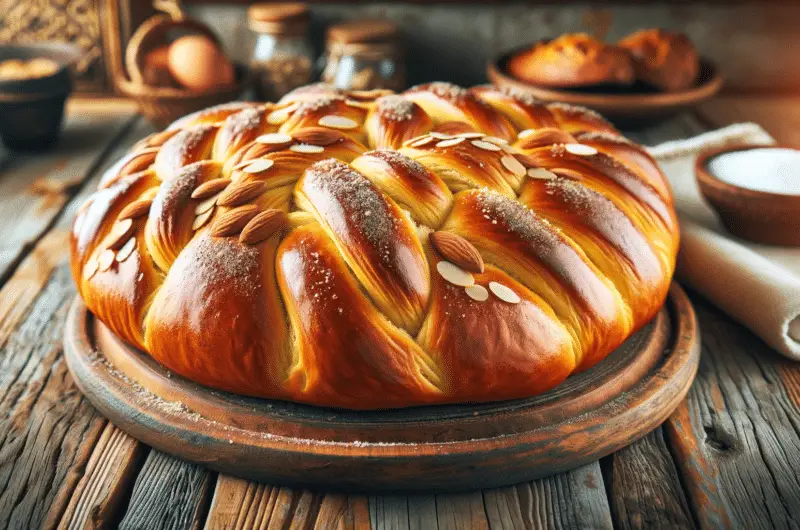Pro Tips
Making Tsoureki, like many traditional recipes, comes with its own set of challenges and nuances. Here are some tips to help you achieve the best results:
- Yeast Activation:
- Ensure the milk is warm, not hot, to activate the yeast. If it’s too hot, it can kill the yeast, and if it’s too cold, it won’t activate properly.
- Flour Quality:
- Use a high-quality all-purpose flour for the best texture. The protein content in the flour can affect how well the dough rises.
- Kneading the Dough:
- Proper kneading is crucial. It develops the gluten in the dough, which gives the bread its structure and texture. Knead until the dough is smooth and elastic.
- Consistency of Dough:
- Tsoureki dough should be slightly sticky and soft. If it’s too firm, the bread can turn out dense.
- Rising Time:
- Be patient with the rising process. The dough should ideally double in size, which can take different amounts of time depending on the temperature and humidity of your environment.
- Spices:
- Mahlepi and mastiha are traditional spices that give Tsoureki its unique flavor. If you can’t find them, you can use cardamom or anise as substitutes, but the flavor profile will be different.
- Egg Wash:
- Apply the egg wash gently. This gives the bread a beautiful golden color and sheen when baked.
- Oven Temperature:
- Make sure your oven is properly preheated. An oven thermometer can help ensure the accuracy of your oven’s temperature settings.
- Don’t Overbake:
- Overbaking can dry out the bread. Keep an eye on it, especially towards the end of the baking time.
- Cooling:
- Allow the bread to cool completely before slicing. This helps the bread set and improves the texture.
- Experimenting with Flavors:
- Once you’re comfortable with the basic recipe, feel free to experiment by adding different flavors like vanilla, almond extract, or even a bit of cognac.
- Storage:
- Tsoureki can dry out quickly. Store it in an airtight container to keep it moist.
Remember, practice makes perfect. Each attempt will bring you closer to mastering this delightful bread. Enjoy the process!
Nutrition Information for Tsoureki
Tsoureki is a rich, sweet bread, and its nutritional profile reflects this. The following is an approximate breakdown per serving, based on the traditional recipe:
- Calories: A slice of Tsoureki (about 1/12th of the loaf) can contain approximately 300-400 calories, largely due to sugar, butter, and eggs.
- Carbohydrates: High in carbs due to the flour and sugar, with each slice containing around 40-60 grams.
- Proteins: Moderate protein content, around 6-10 grams per slice, mainly from eggs and milk.
- Fats: Contains a fair amount of fat (10-15 grams per slice) from eggs and butter.
- Sugars: It’s a sweet bread, so expect a higher sugar content.
- Fiber: Low in dietary fiber.
- Vitamins and Minerals: Provides some B vitamins (from the eggs and enriched flour), as well as minerals like calcium and potassium.
Keep in mind these values are approximate and can vary based on specific ingredients and portion sizes.
What to serve with Tsoureki?
Tsoureki is a versatile bread that pairs well with a variety of accompaniments. Whether you’re enjoying it as part of a special occasion like Easter or as a delightful treat any time of the year, here are some ideas on what to serve with Tsoureki:
- Hot Beverages:
- Serve it with coffee, tea, or hot chocolate. The sweetness of the Tsoureki complements the bitterness of coffee or the warmth of tea perfectly.
- Jams and Spreads:
- Fruit jams, marmalades, or honey are excellent to spread on Tsoureki. The sweetness and fruitiness add another layer of flavor.
- Nutella or other chocolate spreads can also be a decadent choice.
- Cheese:
- Pair it with soft cheeses like cream cheese or mascarpone for a creamy contrast.
- Sliced or spreadable cheeses like Brie or Camembert also work well.
- Yogurt:
- Enjoy Tsoureki with Greek yogurt for a balance of sweet and tangy flavors. Adding a drizzle of honey or some fresh fruits can enhance this pairing.
- Fresh Fruits:
- Serve alongside fresh fruits such as strawberries, oranges, or grapes for a refreshing and lighter option.
- Eggs:
- Tsoureki can be part of a brunch spread that includes eggs prepared in various styles – scrambled, poached, or hard-boiled.
- Savory Spreads:
- Try it with savory spreads like hummus or tzatziki for a unique flavor combination.
- Nuts and Dried Fruits:
- A side of almonds, walnuts, or dried fruits like apricots or figs can complement the flavors in Tsoureki.
- Ice Cream or Desserts:
- Pair it with ice cream or use it in desserts like bread pudding.
- Wine:
- If you’re serving it as part of a festive meal, a sweet dessert wine or a light sparkling wine can be a great accompaniment.
Tsoureki’s sweet, spiced flavor and brioche-like texture make it a delightful and adaptable bread for various pairings. Enjoy experimenting with different combinations to find your favorite way to serve it!
Equipment Needed for Making Tsoureki
- Mixing Bowls: For preparing the dough and yeast mixture.
- Measuring Cups and Spoons: For accurate measurement of ingredients.
- Kitchen Scale: Optional but helpful for precise measurements, especially for flour.
- Dough Mixer: A stand mixer with a dough hook is ideal, but you can also mix and knead by hand.
- Whisk or Fork: To beat the eggs for the dough and egg wash.
- Pastry Brush: For applying the egg wash.
- Baking Sheet: Lined with parchment paper for baking.
- Oven: Preheated to the correct temperature.
- Wire Rack: For cooling the bread after baking.
- Plastic Wrap or Clean Kitchen Towel: To cover the dough during rising times.
- Oven Thermometer: Optional, to check the accuracy of your oven’s temperature.
- Sharp Knife or Dough Scraper: For dividing the dough.
Having the right equipment at hand will make the bread-making process more efficient and enjoyable. Happy baking!
Servings, Prep time, Cooking time & Calories
When making Tsoureki, the Greek bread, the servings, prep time, cooking time, and calorie content can vary based on the size of the loaf and the specific ingredients used. Here’s a general guideline:
Servings
- A standard Tsoureki recipe, like the one I provided earlier, typically makes one large loaf or two smaller loaves. Depending on the slice size, this can serve approximately 10-12 people.
Prep Time
- Initial Prep: Measuring and mixing the ingredients takes about 20-30 minutes.
- Kneading: Approximately 10-15 minutes, either by hand or using a mixer.
- Rising Time: This is the longest part, usually totaling 2-3 hours. The dough needs to rise twice: once after mixing (1-2 hours) and again after shaping (about 1 hour).
Cooking Time
- The baking time for Tsoureki is typically around 25-30 minutes in a preheated oven at 180°C (350°F). However, the exact time can vary depending on your oven and loaf size.
Calories
- The calorie content per serving can be quite variable. A single slice (1/12th of the loaf) can contain approximately 300-400 calories for a standard recipe. This estimate is based on ingredients like flour, sugar, eggs, and butter, which are high in carbohydrates and fats.
These general guidelines can vary based on how you prepare your Tsoureki. For a more accurate calorie count, especially if you’re modifying the recipe or watching your intake, you might consider using a nutritional calculator where you can input the exact amounts and types of ingredients you’re using.


